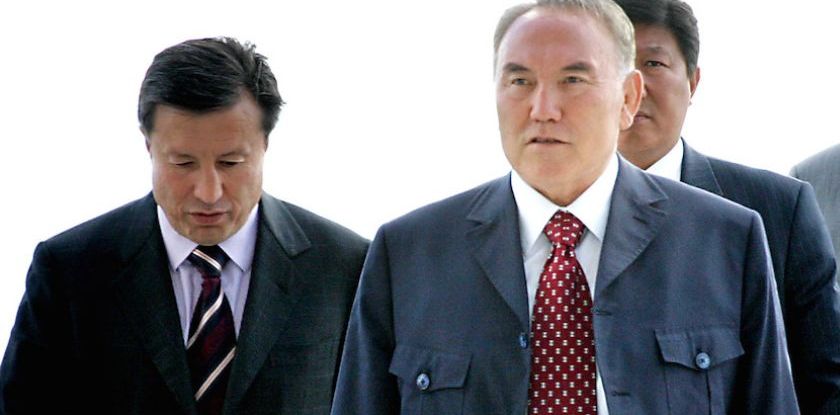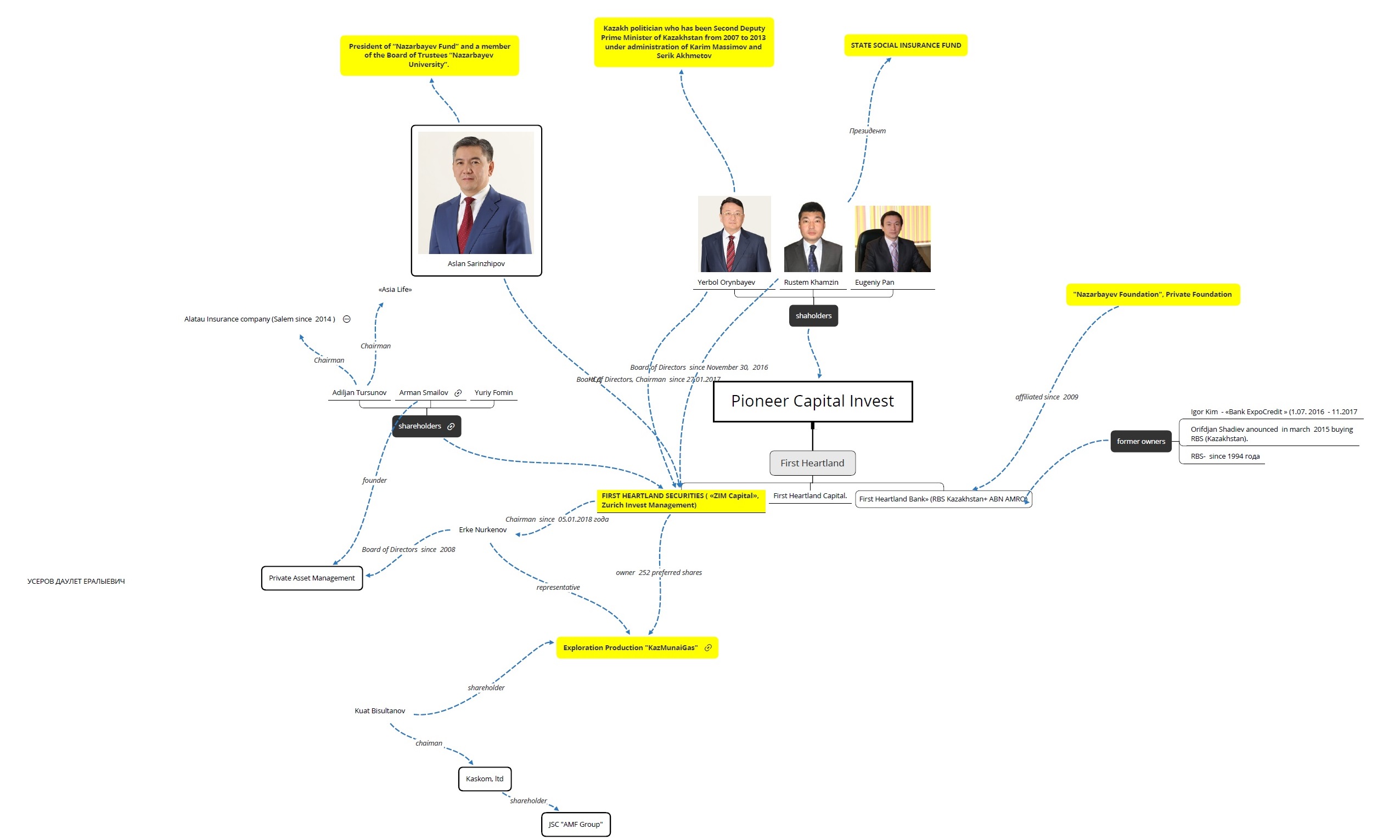The scandal around Tsesnabank that had been transferred from the private hands to the hands of the state monopoly (or, to be more precise, to the hands of the people who have the right for this monopoly) has died out. However, while researching who has gained control over the troubled financial institute, we have elicited some interesting details. These details have helped us to see the contours of the center of a new empire that has potential to lay claims to the power in the country.
We will not going to retell Tsesnabank’s whole story (we have written on its problems in the articles that can be found following the links below this material – kz.expert). We will only recall that, as a result of this story, 99.5% of Tsesnabank’s shares ended up being a property of First Heartland Securities (FHS). Judging from the publications in the Kazakh press, it is a Kazakh broker firm that is a part of the autonomous educational investment holding – Nazarbayev University, Nazarbayev Intellectual Schools and Nazarbayev Foundation.
In other words, it was Nursultan Nazarbayev’s family that has become the end owner of Tsesnabank. Based on insider information, Nazarbayev’s eldest daughter, the Senate Deputy Dariga Nazarbayeva was the main representative of the Leader of the Nation in this project. A more detailed information on the history of the group, its structure and the members of the executive board can be found on the Nazarbayev University website. And even though its operations are based on the principle of autonomy and its status was obtained thanks to the law issued on January 19, 2011, we have no doubt who is really in charge of it.
However, if everything is clear as far as Nazarbayev University, Nazarbayev Intellectual Schools and Nazarbayev Foundation are concerned, then FHS JSC seems to be quite a dark horse. Having followed the usual links between the physical and the legal bodies, we think we have been able to define some of the features of a certain business-archipelago. Let us call it simply – Heartland.
Heartland in the historic context
No one of those who had commented on the Tsesnabank operation, noticed the political nature of the names of the firms involved in the transaction. Meanwhile, in Kazakhstan more than anywhere, names have a special significance. Especially when they have to do with the elite.
In English, Heartland does not simply mean “the core part of the state”. It is not just a word but one of the key concepts of the classic school of geopolitics.
In January 1904, British geographer and Oxford University professor Halford Mackinder presented a report to the Royal Geographical Society. The essence of the report was explained in the article with an extremely pretentious title “The Geographical Pivot of History”. It was this publication that served as the start of the development of real geopolitics that experienced its bloom as an academic discipline in the first half of the 20th century. In the second half, it moved into the depths of the secret service in order to be resurrected in the mass communications’ popular interpretations.
We will not analyze Mackinder’s conclusions in depth but remark on his main concept. It is the infamous Heartland – the massive part of the North-Eastern Eurasia rimmed with the mountains in the south and the east. Mackinder believed that controlling this region would provide the control over the entire Eurasia (including Europe which was particularly important for the political beau-monde of the time). The latter circumstance was especially significant for Great Britain that had aspired (and quite successfully so) to perform this role but, in the beginning of the 20th century, faced the problem of losing the control of the region.
Dr. Mackinder’s ideas could have been regarded as historical curiosities had it not been for the subsequent wars and revolutions happening from China to Germany. They had destroyed the Eurasian threat (or rather postponed it for a century as the modern specialists in the popular geopolitics would have you believe).
Regardless of whether these deductions correspond to reality or not, the political views of a number of the regional leaders experience a strong influence of this doctrine. Nursultan Nazarbayev is the most prominent representative of this branch of politicians. Therefore, the name of the business itself has not only a political but a geopolitical significance as well.
The Zurich investors from Komsomol Street
FHS was born very recently, in March 2018. Before that, another firm had had the broker and dealer license – ZIM Capital born in March 2014. And before that, the license belonged to Zurich Invest Management. It also obtained the license in March albeit it was March 2009.
We will recall that the year 2009 was very difficult for the national and international financial system. And it seems that creating a new business needed some special foundation.
In contrast with its name, the office of the firm was located on modest Tole bi Street, bldg. 83. The previous name of the street (Komsomolskaya) reflects the company’s strategy quite vividly. Now we can read about that only on the archive version of the website. In this digital historic document, Zurich Investment Management is called “a young and one of the fastest growing broker firms”.
But, if the youth of the “Zurich” investors was fading away, the situation with their growth and the development dynamics was much more complicated. The firm remained in the shadows of the Kazakh stock market despite its modest size. According to the National Bank’s data, FHS occupied the last place among the 13 broker conglomerates in terms of the capital stock. At that point, its main shareholders included insurance entrepreneur Adilzhan Tursunov, racer Arman Smailov and a certain Yuri Fomin. Numerous members of their families are listed as the affiliated parties.
Quite obviously, the name of Smailov was the first one we noticed, however, despite the existence of an abundance of the people with the same surname among the affiliated parties, we have been unable to find a connection between the former Presidential advisor and current Minister of Finance Alikhan Smailov. Even though the presence of the racer among the “Zurich investors” does seem odd.
One of the shareholders who has been appointed the firm’s Chairman of the Board Adilzhan Serikovich Tursunov is known in Kazakhstan in connection to the insurance business. At the time of Zurich Invest Management’s creation, he was serving as the Chairman of the Board of the Alatay insurance company. In 2014, Alatay was transformed into the Salem insurance company while Adilzhan Tursunov became the Chairman of the Board of a new insurance company Asia Life.
The chain of the reshuffles allows to define the basic features of the business-archipelago where each element has its own individual purpose. And while it can change it (as well as the name and the shareholders), its place in the general business-net remains intact.
The banks of Heartland
Tsesnabank is already the second element in the bank holding formed by FHS. It already includes First Heartand Bank that has its own remarkable history. Once it was the Kazakh affiliated structure of Royal Bank of Scotland (RBS).
RBS was the first bank with foreign participation that came in Kazakhstan as early as in 1994 when very few people outside of the professional oil producers’ community even knew of this country’s existence. For a long period of time, the bank had been operating as a typical ex-patriot institute working with corporate clients, providing syndicated lending and trade funding. Little had changed even when, in 2008, the Kazakh branch of bank ABN AMRO, following the footsteps of its Dutch mother, became a part of the RBS group.
However, in March 2012, the Kazakh office of RBS came to life. It was then when it became known that Royal Bank of Scotland plc, its British “mother” decided to consolidate on its balance all the shares of the bank with the Kazakh license, purchased 80% of the shares from its own holding structure RBS N.V. and bought the remaining 20% from IFC (a branch of World Bank).
Most likely, this had to do with the forced reorganization that the bank was undergoing at home due to the pressure of the serious financial problems. By the looks of it, however, the Kazakh deal was not just a nominal transaction. Consider that the corporate clients had rushed away from the bank and, by the end of 2012, the assets of DB RBS shrank by about 40%.
It was only three years later that the public learned about the fact that the insiders had had the serious grounds for concerns. In March 2015, Orifdzhan Shadiyev who, in 2013, bought 100% of TAIB Kazakh Bank’s shares and renamed it Capital Bank Kazakhstan announced that he had purchased the Kazakh business of RBS.
Shadiyev is a nephew of Patokh Shodiyev, one of the shareholders of Eurasian resource group ERG.
At the time, Shodiyev and his colleagues were engaged in transforming ENRC from a public corporation whose shares were listed at the LSE into a Kazakh LLP. Once, it was the Kazakh branch of ABN AMRO that was responsible for listing the shares. It was also the company that conducted the IPOs of KazMunaiGas Exploration Production and it was also the firm that sold KazMunaiGaz NC’ securities.
All these operations were of a purely market nature. In Kazakhstan, however, any such transactions are usually strategic, in other words, they involve the interests of influential and powerful persons.
Shadiyev did not hold on to the status of RBS’ Kazakh branch buyer for long. Although he did obtain the transaction authorization from the National Bank of Kazakhstan, he chose not to buy the bank. It is still unknown what his representatives were doing there, however, Shadiyev relinquished the role of the buyer to serial banker Igor Kim who, at the beginning of 2016, already purchased the Russian branch of RBS. The Kazakh branch, therefore, was an addition to Kim’s portfolio and the bank’s name was changed to Expofinance.
At the start of 2018, the bank, once again, changed the owner. This time, it was broker firm ZIM Capital. It was this company that, after the renaming, had become First Heartland (thus changing the name of the bank once again). Now the empire that is growing right before our eyes has its own financial heartland.
Whether First Heartland and Tsesnabank will merge or not is unknown but, more likely than not, they may be used as corporate dash-boards – the panel for controlling the real assets. Currently, the access to such panels may become the most important element in the building of an independent system of the economy management in the country.
Thus, we are now at the center of this war. At its very Heartland.
Click on the scheme to augment it. Two clicks provide the maximal scale.







